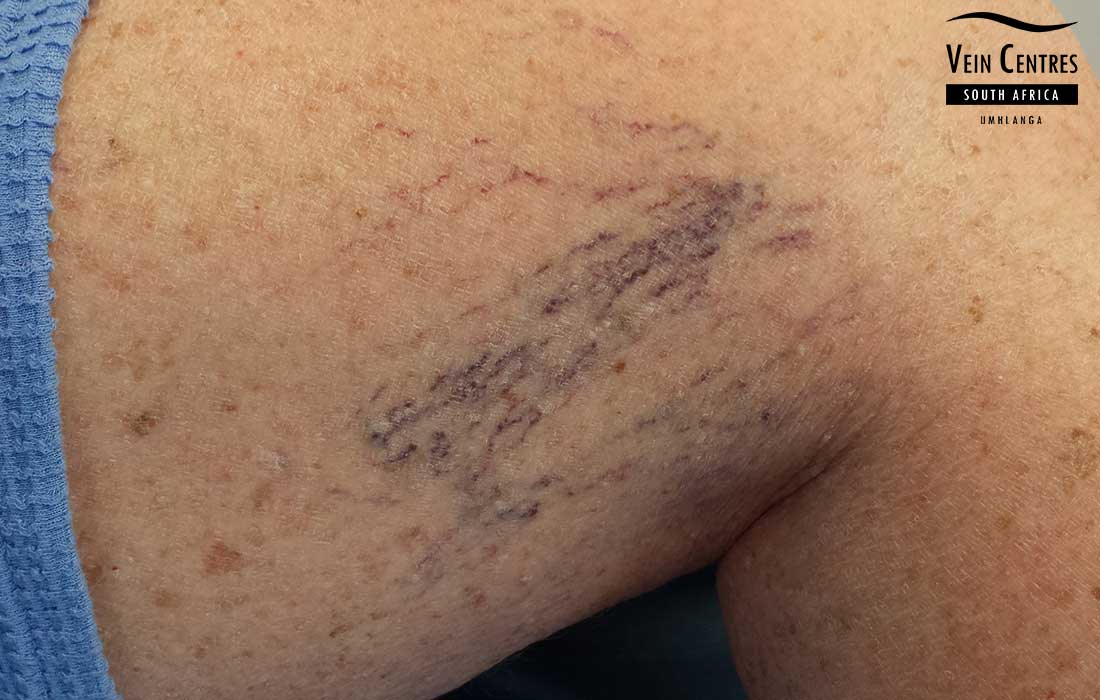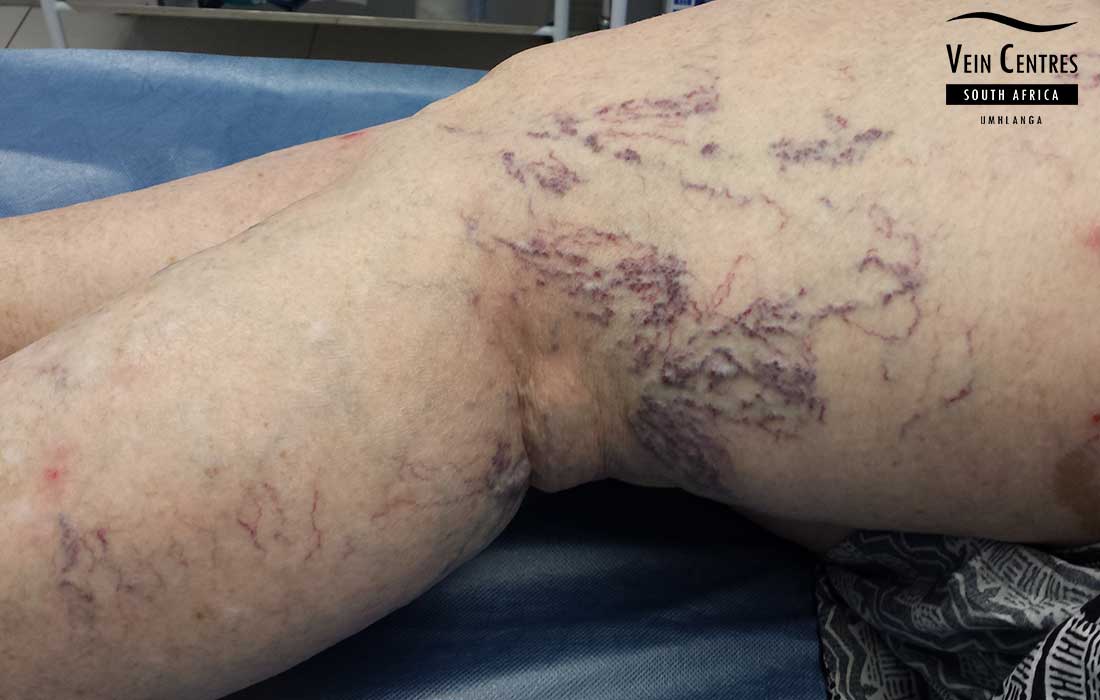About Spider Veins
Spider veins are small blue or red veins located just below the outer surface of the skin. They often have a web-like appearance, hence, the term spider vein. Most spider veins have an unattractive cosmetic effect and, in some cases, may give rise to symptoms such as itching, burning, or throbbing of the legs. Veins are arranged in layers within and under the skin. The very smallest type of veins are on the surface, these veins drain into slightly larger veins, called reticular veins, which lie deeper within the skin. Faulty reticular veins often act as "feeding" veins to the smaller superficial spider veins. The most prominent reticular vein is the lateral vein of the thigh. This vein is often involved in causing spider veins of the outside thigh. Treating the smaller veins on the surface, without addressing this important vein, leads to poor treatment results.
Spider Veins
What are spider veins?
Spider veins are like varicose veins but much smaller. They are thin red or blue lines, close to the surface of the skin. They can look like tree branches or spiderwebs with their short, jagged lines. Spider veins are found on the legs and face and can cover either a small or very large area of skin.
Spider veins symptoms
Most spider veins do not cause any symptoms apart from the cosmetic issues. Some patients will report burning or itching in their larger spider veins. These symptoms are often worse on warm days or with monthly menses in women. The actual vein, in a spider vein, is translucent, the colour that is observed depends on the colour of the blood flowing through the vein. Very small superficial spider veins are red, and can often look like a bruise. Larger spider veins, located deeper within the skin, often have a blueish appearance. In spider vein patients with leg pain, swelling, heaviness, restlessness ans skin changes, another cause for the veins should be sought. These patients often have undiagnosed venous reflux, and would require an endovenous procedure to treat the reflux, prior to having their spider veins treated.
Spider veins causes
Spider veins are common and affect 50-80% of the general population, both men and women. All skin types are prone to the development of spider veins, for obvious reasons they are more visible in light skin and less obvious in darker skin. A family history of vein disease in parents or siblings predict a higher risk of developing spider veins. Other causes like trauma to the skin accounts for a small portion of spider veins.
Myths
There are many myths around the causes of spider veins today. Some of these include crossing your legs, wearing high heels, taking very hot baths and wearing tight clothes.
Using venotonic drugs and creams will remove my spider veins. There are a variety of online and printed ads promoting creams and medicines to cure your veins. With our extensive experience in treating all kinds of vein patients, we can assure you that nothing is further from the truth.
Spider veins treatment
In top vein clinics around the world, the gold standard in treating spider veins remain sclerotherapy. We exclusively use sclerotherapy in treating spider veins. By treating throusands of vein patients, we have developed our our treatment protocols. This means we use drugs indicated for the treatment of veins. We do not use solutions of salt or sugar water in treating veins, as practiced in the past. We strictly control the dose of the sclerosant that each patient receives to ensure the absolute best outcome in every case. Following treatment you will be required to wear compression stockings to aid this treatment. Failure to do so will lead to sub-optimal results.
There is an unfortunate reality to spider veins, once treated, new veins can form over time and would require treatment again. Whilst most of our patients experience an excellent clearance of their spider veins and go on to enjoy many years of great-looking legs, some patients are less fortunate, simply due either to their own individual biology, to specific life events such as pregnancy or even to prolonged use of the oral contraceptive pill.
Treating spider veins is much like dental care, and ongoing effort is required to keep looking good!
Read More about Sclerotherapy
Alternative treatments
Although sclerotherapy is the accepted gold standard in treating spider veins, many alternative treatments are available. We often see patients who have tried these other treatments and report disappointing results and sometimes even worsening in their veins.
Tablets and dietary supplements for veins
Many tablets and supplements are sold with the promise to keep your legs healthy and improve the symptoms of vein disease. These drugs are known as venotonic drugs and often based on red vine leaf extract. Unfortunately the scientific evidence being used to market these drugs are scant at best. I always find it interesting that a patient would choose to take these drugs for many years without having the root cause treated. The long term effects of these drugs are not known. In our practice we have had very few patients actually reporting these drugs to be useful. There might be a role for venotonic drugs in patients who suffer from post thrombotic syndrome.
Creams
Urea creams, Vitamin K creams the list goes on. At best these creams might have a temporary effect at hiding the veins, but certainly there is no proof of treatment. Some creams are intended to mask the veins, similar to using make-up.
Laser or IPL
Many clinics use laser or intense pulsed light(IPL) devices to treat leg spider veins. These devices operate at a wavelength that specifically targets haemoglobin, the red pigment of blood. Although highly effective on the red vessels of the face and neck, we do not use or recommend them for spider veins on the legs. This type of treatment misses the vital step of treating ‘feeding’ veins or hidden varicose veins and, as such, delivers results far inferior to our chosen sclerotherapy technique. Applying enough heat energy to a spider vein to actually destroy it, increases the risk of skin burns. ‘Burnt’ skin heals over time, but it can become either de-pigmented (whiter than the surrounding skin) or pink, shiny and ‘hyperpigmented’ (darker than the surrounding skin).
Spider veins prevention
Our current understanding of spider veins would suggest that you cannot prevent spider veins from forming.
Spider Veins Diagnosis
Venous duplex ultrasound scanning is the current gold standard in the diagnosis of vein disease. It involves the use of an ultrasound machine and high frequency probe to accurately asses the anatomy of your veins as well as the flow patterns wihin them. Ultrasound scanners do not produce any radiation (unlike x-rays) and they don’t involve needles or injections. Hand-held dopplers are not used in our vein centres as they are inaccurate. Every new patient will undergo a duplex examination prior to any treatment planning. Not accurately diagnosing underlying vein problems will lead to sub-optimal treatment outcomes. This is often why we see patients who have beeen treated elsewhere, that presents with a worsening in their veins.




